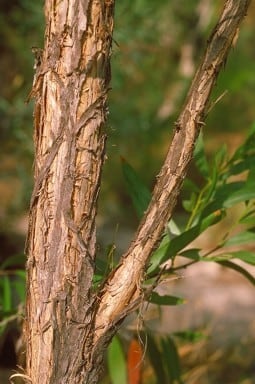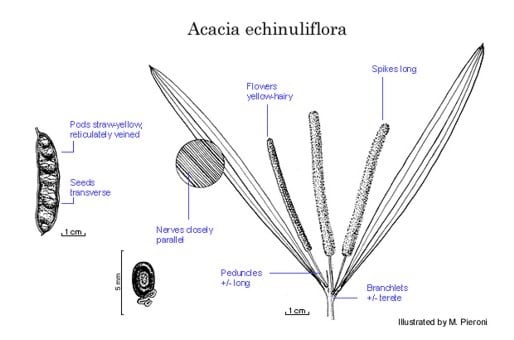Acacia echinuliflora G.J.Leach
WATTLE
Acacias of Australia
Family
Fabaceae
Distribution
Occurs along the escarpment of western Arnhem Land and southwards to Nitmiluk Natl Park, N.T.
Description
Tree or rarely a shrub (2.5–) 4–8 m high. Bark fibrous or shaggy, brown to black. Branchlets terete, reddish brown, resinous. Phyllodes narrowly elliptic or oblanceolate, flat, straight or slightly curved, 9–18.5 cm long, 6–16 mm wide, thinly coriaceous, glabrous, shiny; midrib and two secondary nerves more prominent; minor nerves 4–8 per mm, parallel, anastomoses absent or very few; gland 1, basal, inconspicuous. Spikes 1 or 2 per axil, 5–7 cm long, bright yellow to golden. Flowers 5-merous; receptacle, calyx, corolla tube and base of lobes densely tomentose with yellow or rarely hyaline hairs; sepals free, 0.45–0.9 mm long; corolla 0.9–1.4 mm long, dissected to ½ its length; ovary densely sericeous. Pods linear to oblong, straight, undulate, raised over seeds alternately on each side, 7–10 mm wide, straw-coloured, transversely reticulate, resinous. Seeds transverse, oblong or elliptic, brown or black, arillate; pleurogram with pale halo; areole closed, depressed, paler than seed.
Phenology
Flowers June–Aug.
Habitat
Grows on sandy soils associated with stream margins draining the escarpment.
Specimens
N.T.: Jim Jim Creek, N.Byrnes 2729 (BRI, CANB, DNA, NSW); Barramundie Gorge, I.Cowie 141 (DNA); Mt Gilruth area, C.R.Dunlop 4868 (BRI, CANB, DNA, K, NSW); UDP Falls, J.Mckean 1137 (CANB, DNA); Edith Falls, J.Must 1664 (CANB, DNA, NSW).
Notes
Acacia echinuliflora is most closely related to A. plectocarpa and A. armitii but differs from both in having petals with an indumentum of dense, patent, yellow hairs (G.Leach, Nuytsia 9: 355–357 (1994)).
FOA Reference
Data derived from Flora of Australia Volumes 11A (2001), 11B (2001) and 12 (1998), products of ABRS, ©Commonwealth of Australia
Author
G.J.Leach
Minor edits by B.R.Maslin & J.Rogers
This identification key and fact sheets are available as a mobile application:
URL: https://apps.lucidcentral.org/wattle/
© Copyright 2018. All rights reserved.











